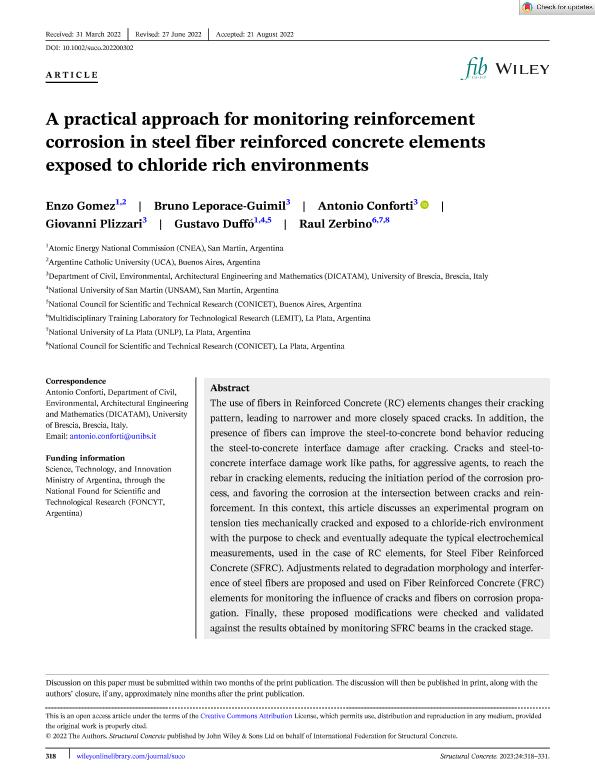Mostrar el registro sencillo del ítem
dc.contributor.author
Gomez, Enzo David

dc.contributor.author
Leporace Guimil, Bruno

dc.contributor.author
Conforti, Antonio
dc.contributor.author
Plizzari, Giovanni
dc.contributor.author
Duffó, Gustavo Sergio

dc.contributor.author
Zerbino, Raul Luis

dc.date.available
2023-12-12T13:17:45Z
dc.date.issued
2023-01
dc.identifier.citation
Gomez, Enzo David; Leporace Guimil, Bruno; Conforti, Antonio; Plizzari, Giovanni; Duffó, Gustavo Sergio; et al.; A practical approach for monitoring reinforcement corrosion in steel fiber reinforced concrete elements exposed to chloride rich environments; John Wiley & Sons; Structural Concrete; 24; 1; 1-2023; 318-331
dc.identifier.issn
1464-4177
dc.identifier.uri
http://hdl.handle.net/11336/219967
dc.description.abstract
The use of fibers in Reinforced Concrete (RC) elements changes their crackingpattern, leading to narrower and more closely spaced cracks. In addition, thepresence of fibers can improve the steel-to-concrete bond behavior reducingthe steel-to-concrete interface damage after cracking. Cracks and steel-to-concrete interface damage work like paths, for aggressive agents, to reach therebar in cracking elements, reducing the initiation period of the corrosion pro-cess, and favoring the corrosion at the intersection between cracks and rein-forcement. In this context, this article discusses an experimental program ontension ties mechanically cracked and exposed to a chloride-rich environmentwith the purpose to check and eventually adequate the typical electrochemicalmeasurements, used in the case of RC elements, for Steel Fiber ReinforcedConcrete (SFRC). Adjustments related to degradation morphology and interfer-ence of steel fibers are proposed and used on Fiber Reinforced Concrete (FRC)elements for monitoring the influence of cracks and fibers on corrosion propa-gation. Finally, these proposed modifications were checked and validatedagainst the results obtained by monitoring SFRC beams in the cracked stage.
dc.format
application/pdf
dc.language.iso
eng
dc.publisher
John Wiley & Sons

dc.rights
info:eu-repo/semantics/openAccess
dc.rights.uri
https://creativecommons.org/licenses/by-nc-sa/2.5/ar/
dc.subject
CORROSION MONITORING
dc.subject
CORROSION POTENTIAL
dc.subject
FIBERS REINFORCED CONCRETE
dc.subject
PITTING CORROSION
dc.subject
RESISTIVITY
dc.subject.classification
Ingeniería Civil

dc.subject.classification
Ingeniería Civil

dc.subject.classification
INGENIERÍAS Y TECNOLOGÍAS

dc.title
A practical approach for monitoring reinforcement corrosion in steel fiber reinforced concrete elements exposed to chloride rich environments
dc.type
info:eu-repo/semantics/article
dc.type
info:ar-repo/semantics/artículo
dc.type
info:eu-repo/semantics/publishedVersion
dc.date.updated
2023-12-07T17:50:38Z
dc.journal.volume
24
dc.journal.number
1
dc.journal.pagination
318-331
dc.journal.pais
Estados Unidos

dc.description.fil
Fil: Gomez, Enzo David. Comisión Nacional de Energía Atómica; Argentina. Pontificia Universidad Católica Argentina "Santa María de los Buenos Aires"; Argentina
dc.description.fil
Fil: Leporace Guimil, Bruno. Università Degli Studi Di Brescia; Italia
dc.description.fil
Fil: Conforti, Antonio. Università Degli Studi Di Brescia; Italia
dc.description.fil
Fil: Plizzari, Giovanni. Università Degli Studi Di Brescia; Italia
dc.description.fil
Fil: Duffó, Gustavo Sergio. Comisión Nacional de Energía Atómica; Argentina. Universidad Nacional de San Martín; Argentina. Consejo Nacional de Investigaciones Científicas y Técnicas; Argentina
dc.description.fil
Fil: Zerbino, Raul Luis. Universidad Nacional de La Plata; Argentina. Consejo Nacional de Investigaciones Científicas y Técnicas; Argentina. Multidisciplinary Training Laboratory for Technological Research; Argentina
dc.journal.title
Structural Concrete
dc.relation.alternativeid
info:eu-repo/semantics/altIdentifier/url/https://onlinelibrary.wiley.com/doi/10.1002/suco.202200302
dc.relation.alternativeid
info:eu-repo/semantics/altIdentifier/doi/http://dx.doi.org/10.1002/suco.202200302
Archivos asociados
